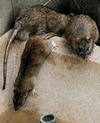Rats and mice carry zoonotic diseases

Mice and rats may carry many bacteria and viruses that are hazardous both to other animals and to people. Scientists from the Faculty of Agricultural Sciences at the University of Aarhus are trying to identify which diseases Danish rats and mice are carrying.
Brown eyes, soft fur, lively behaviour: They may sound like the ultimate pet, but they are animals that we despise. We are talking about wild rats and mice and there is every good reason to keep them at a distance. Not only do they create much material damage and undermine roads, houses and livestock buildings, but they can also be carriers of contagious diseases.
Scientists from the Department of Integrated Pest Management at the Faculty of Agricultural Sciences (DJF) at the University of Aarhus are focusing research on some of the contagions the small rodents carry around with them.
One of the research projects consists of collecting sewer rats and examining them for the leptospirosis bacteria (Weil�s Disease) that can be passed on to humans. The disease starts with influenza-like symptoms and can end in kidney failure. If you do not receive treatment within 15 days, your life may be at risk.
- Preliminary investigations show that Leptospira bacteria may be present in many more rats than previously assumed, says scientist and biologist Ann-Charlotte Heiberg.
There is, however, a difference in how pathogenic the different Leptospira organisms are. DJF collaborates with Statens Serum Institut to try and identify the specific Leptospira species and serotypes that the captured rats may carry.
Another Leptospira, which is carried only by the field mouse and which so far has been discovered only on Lolland, is dangerous to pigs as it may cause miscarriages in sows. Mice tested positive for Leptospira have been found in pig houses on Lolland and as other types of Leptospira may be found in other parts of the country, DJF wishes to test mice for Leptospira in the herds that have problems with miscarriages.
Kidney problems, breast cancer and mice
As part of an international research project on the Hantavirus, scientists from DJF are also capturing mice from Funen and an area south of Aarhus. The common bank vole is the host of this virus, which can cause serious liver damage in humans. The mouse typically lives in woodpiles and in semi-wooded areas.
By contaminating the captured mice with the Hantavirus it may be possible to determine whether the problems that are limited to certain areas are due to genetics.
Mice from the southern part of Jutland are also collected, as this area has a relatively high incidence of breast cancer. Mice may possibly be involved in this as certain forms of breast cancer may be caused by the transfer of the so-called Mouse Mammary Tumour Virus (MMTV). Scientists will investigate whether mice in Southern Jutland carry MMTV.
For further information please contact:
Senior scientist and biologist Jens Lodal, Dept. of Integrated Pest Management, University of Aarhus, e-mail: [email protected], telephone: +45 8999 3944
Scientist and biologist Ann-Charlotte Heiberg, Dept. of Integrated Pest Management, University of Aarhus, e-mail: [email protected], telephone: +45 8999 3946.


 Tel: +45 8999 1900
Tel: +45 8999 1900